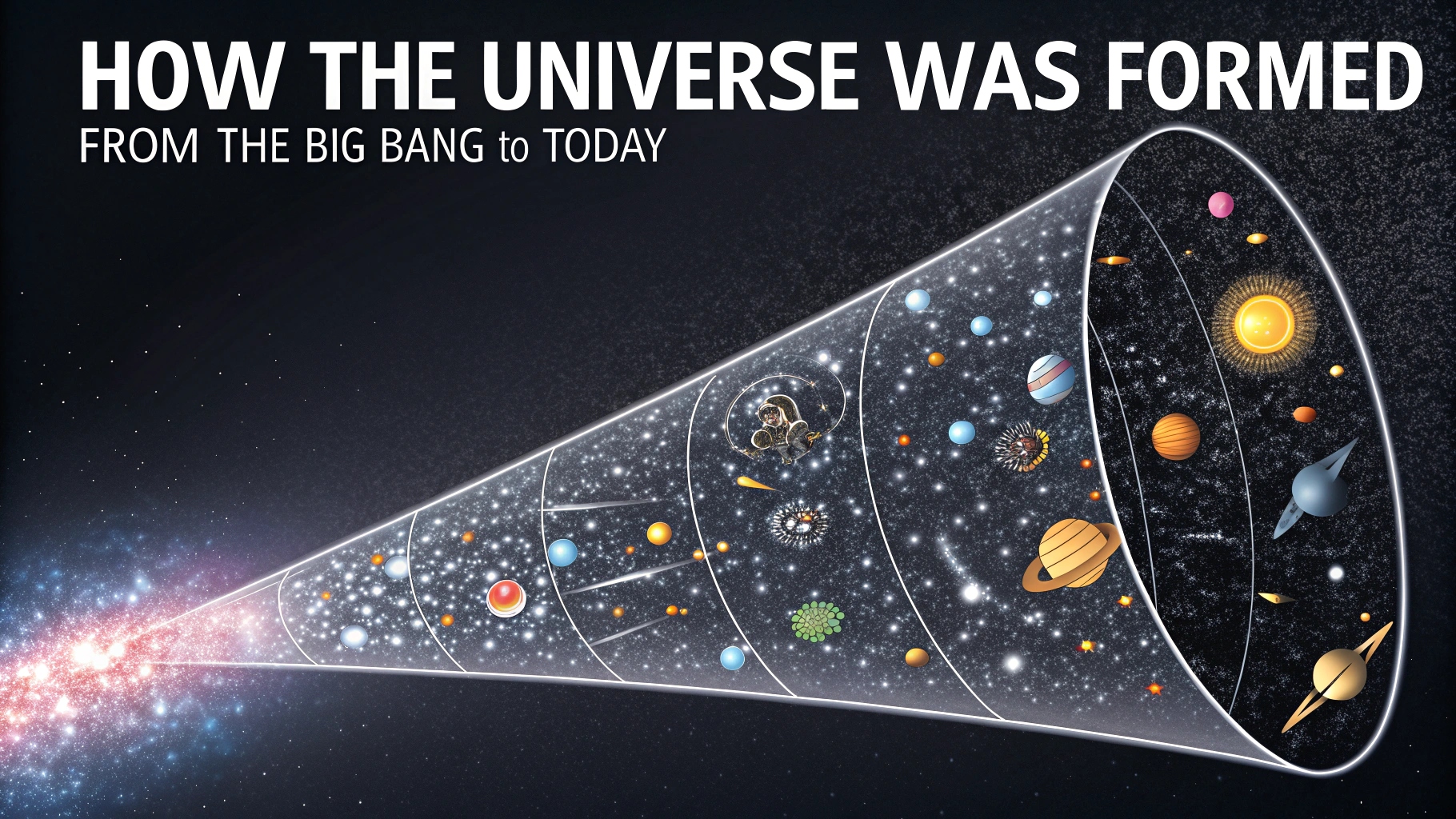How the Universe Was Formed: From the Big Bang to Today
Introduction
The story of how everything began is one of the most profound questions humanity has ever asked. Modern science, through observations, mathematics, and technological advances, has pieced together a detailed picture of how the Universe came into existence, evolved, and continues to expand today. This journey takes us from the instant of the Big Bang nearly 13.8 billion years ago, through the formation of galaxies and stars, all the way to the present moment.
The Big Bang: The Beginning of Time and Space
The widely accepted explanation for the origin of the cosmos is the Big Bang theory. According to this model, the Universe began as an unimaginably hot, dense point—sometimes referred to as a singularity. Roughly 13.8 billion years ago, it rapidly expanded in an event we call the Big Bang.
This was not an explosion in space, but rather the expansion of space itself. Time, energy, matter, and the laws of physics were all born at that moment. Within the first fractions of a second, the cosmos underwent an inflationary period, expanding faster than the speed of light. This helped explain why the observable regions of space appear uniform, even though they are so far apart.
The Formation of Matter
As the cosmos cooled after the Big Bang, energy transformed into fundamental particles. Protons, neutrons, and electrons emerged from the early soup of subatomic particles. In just a few minutes, nuclear fusion produced light elements such as hydrogen, helium, and small traces of lithium.
This period, known as Big Bang nucleosynthesis, set the chemical foundation for everything that followed. For hundreds of thousands of years, however, the cosmos remained a hot, opaque plasma of particles and radiation. Light could not travel freely because photons were constantly scattering off electrons.
The Cosmic Microwave Background
About 380,000 years after the Big Bang, the cosmos cooled enough for electrons to combine with protons and form neutral atoms. This process is called recombination. At this point, photons were able to move freely through space, producing a faint glow known today as the cosmic microwave background (CMB).
The discovery of the CMB in 1965 by Arno Penzias and Robert Wilson provided strong evidence for the Big Bang theory. This relic radiation acts like a snapshot of the cosmos in its infancy, showing slight temperature variations that later evolved into galaxies and large-scale structures.
The Birth of the First Stars and Galaxies
With hydrogen and helium filling the cosmos, gravity began to pull matter together. Over hundreds of millions of years, small clumps of gas condensed, triggering the birth of the first stars. These massive stars were short-lived but crucial, as they fused heavier elements in their cores and spread them across space through supernova explosions.
Galaxies began to form as gravity continued to draw stars together. These early structures eventually gave rise to spiral galaxies like the Milky Way and elliptical galaxies that we see today. The first stars illuminated Universe the cosmos, ending the so-called “cosmic dark ages” and allowing light to travel freely across great distances.
The Formation of Solar Systems
As galaxies matured, smaller structures like solar systems developed within them. Clouds of gas and dust collapsed under gravity to form new stars, often surrounded by rotating disks of material. From these disks, planets, moons, and other celestial bodies emerged.
Our own solar system was born about 4.6 billion years ago in the Milky Way galaxy. The Sun ignited at the center of a collapsing cloud of gas, while planets—including Earth—formed from the leftover debris. Over Universe billions of years, conditions on Earth allowed life to emerge and eventually evolve into the complex diversity we see today.
Expansion and Dark Energy
One of the most remarkable discoveries in cosmology came in the late 20th century. Astronomers studying distant supernovae found that not only is the cosmos expanding, but the rate of expansion is actually accelerating. This phenomenon is attributed to a mysterious force called dark energy.
Dark energy makes up roughly 70% of the total energy content of the cosmos, yet its true nature remains unknown. Along with dark matter—which interacts with gravity but not light—it dominates the large-scale structure and fate of the Universe.
The Role of Black Holes
Another fascinating element of cosmic evolution is the role of black holes. These are regions of space where gravity is so strong that not even light can escape. Supermassive black holes, millions to billions of Universe times more massive than the Sun, reside at the centers of most galaxies. They influence the growth and dynamics of galaxies, shaping their evolution over billions of years.
The Present-Day Universe
Today, the cosmos is a vast and complex network of galaxies, stars, planets, and other structures connected by invisible filaments of dark matter. Telescopes like the Hubble Space Telescope and the James Webb Universe Space Telescope allow us to peer back in time, observing light that has traveled billions of years to reach us.
Our own Milky Way galaxy contains more than 100 billion stars, many with planets orbiting them. Scientists continue to search for Earth-like planets that might host life. At the same time, physicists and astronomers work to understand dark matter, dark energy, and other mysteries that shape the large-scale behavior of the cosmos.
The Future of the Universe
What lies ahead? Several possibilities exist depending on the behavior of dark energy and gravity. If expansion continues to accelerate indefinitely, galaxies will drift farther apart until they are isolated. This scenario is sometimes called the “Big Freeze,” where stars eventually burn out, leaving a cold and dark cosmos.
Other possibilities include a “Big Rip,” where expansion becomes so powerful that it tears apart galaxies, stars, and even atoms. Alternatively, if dark energy behaves differently than we expect, the cosmos could one Universe day collapse back in on itself in a “Big Crunch.” While these outcomes are billions or trillions of years away, they highlight the ongoing quest to understand the ultimate fate of everything.
Conclusion
The formation of the Universe is a story of transformation, beginning with the Big Bang and unfolding through countless stages of cosmic evolution. From the birth of atoms to the emergence of stars, galaxies, planets, and life itself, it is a narrative that connects us directly to the cosmos.







